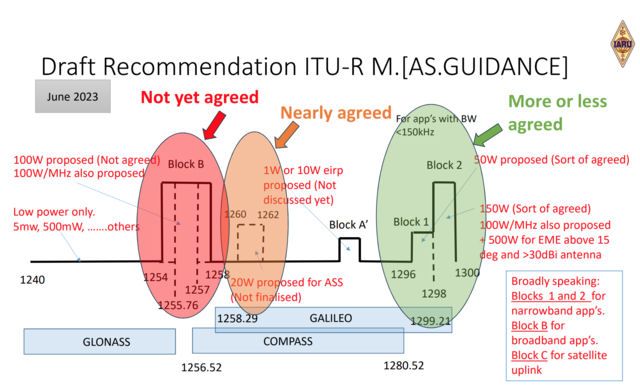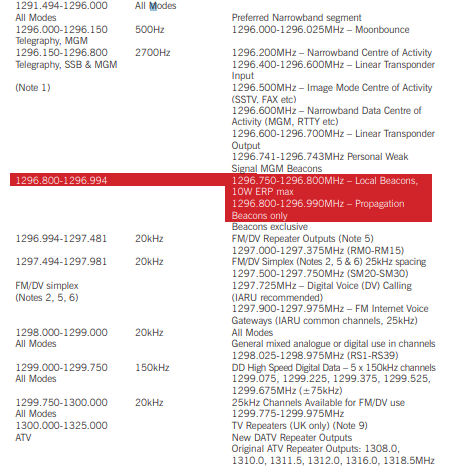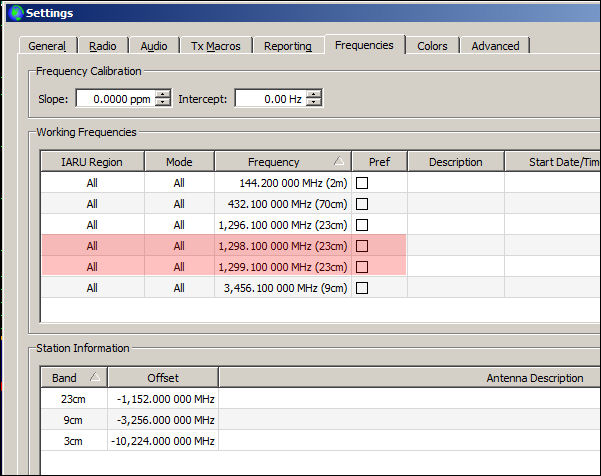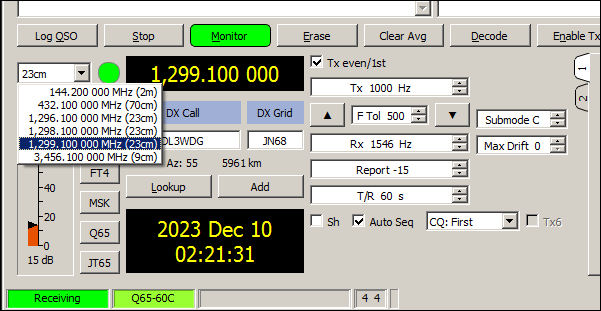Moving 23cm EME from 1296 to 1298Mhs

History: Why are we on 1296MHz to start with? Some newer Hams may not remember the days when high frequencies were generated using multipliers form lower bands and narrowband frequencies were harmonically related. 144MHz could be tripled to 432, 432 could be tripled to 1296 (and 1296 could be multiplied by 8 [2x2x2] to give 10.368GHz). That's the origin of 1296 as the "standard" 23cm band frequency. But probably not for much longer.
During the WRC-23 deliberations, strong positions were expressed by all the parties involved. The result is a well-supported compromise for a footnote in the Radio Regulations regarding amateur and amateur satellite service operation in the 1240–1300 MHz range. The footnote reminds administrations and amateurs of the need to protect the primary RNSS from interference and provides guidance to administrations to allow both services to continue to operate in this portion of the spectrum. The compromise was formally adopted by the Conference Plenary on December 8 and is not subject to further consideration during the final week of the WRC. The IARU team continues its work on other WRC issues including the development of agendas for future conferences.
I believe that being in a footnote allows Regulatory agencies more flexibility in applying the recommendations. The actual details appear to be as follows (for narrowband operation).
- 1296-1298 MHz: Maximum transmitter power = 17dBW (50.1W)
- 1298-1300 MHz: Maximum transmitter power = 22 dBW (158.5W)
- For narrowband Earth-Moon-Earth applications in the amateur service using a
symmetric high-performance antenna (e.g. boresight gain at least 30 dBi) pointing at
least 15 degrees above the horizontal:
1298-1300 MHz: Maximum transmitter power3 = 27 dBW (501.2W)
From the WRC23 meeting it appears that 23cm EME operation will be moving from 1296MHz to 1299MHz sometime in the 2024 or 2025 time frame. WRC23 are endorsing, recommending - but not mandating - a plan which allows the following operating limits for narrowband operation on 23cm:
- 1296-1300 : 50w terrestrial and EME
- 1298-1300 : 158W terrestrial and EME
- 1298-1300 : 500W for EME (only) if the antennas has >30dBi gain and the elevation is >15 degrees (they are trying to keep sidelobes pointing at the sky)
Here's the graphic version. The "more or less agreed" section seems like the final recommendation.

While this would seem to allow EME operation to continue at 1296, power would be limited to 50W. The most sensible arrangement would appear to be to move all EME operation to 1299MHz where small antennas stations would have a 150W power limit and 30dBi and up stations (~3m dish) could increase power to 500W for EME once the moon was above 15 degree elevation. While some may say that these regulations don't really make sense, they are most likely what we will have and any station planning EME operation should keep them in mind.
It appears that it may be up to individual licensing authorities to choose to implement these recommendations, there's little doubt that European licensing authorities will do so. It remains to be seen what changes to current authorizations for 23cm operation in the US will be. Whatever happens, it's likely that worldwide 23cm operation will move to 1298MHz, probably sometime in 2024. I would not be surprised to see 2024 ARRL EME contest on 23cm mostly or totally at 1298MHz. I'm assuming a move to 1298MHz rather than 1299MHz at the moment. One may suffer more from QRM due to cell towers or similar RF sources of interference then the other. I don't know because I never listen at those frequencies and I'm not in an urban environment. Presumably there will be some discussion of that the default frequency should be among 23cm EME operators before any move is finalized. 1289 and 1299 would both require the same system/LO modifications (if modifications are needed).
The FCC has nothing to say about bandplans. Part 97 regulations simply state the allocation is 1240-1300MHz, Amateur stations must accept interference from and not cause interferece to services such as radiolocation whether such stations are owmed by the US or other nations. The only power limit outside the usual power limitations for amateur service (1500W) is station controlled by novices are limited to 5W.
The ARRL bandplan (which is a voluntary agreement ti avoid chaos on the bands) is pretty nebulous in the region of interest:
- 1295.800-1296.080 - CW, SSB, digital, EME
- 1296.080-1296.200 - CW, SSB, Weak Signal
- 1296.200-1296.400 - CW, digital, Beacons
- 1296.400-1297.000 - Various, General Narrow Band
- 1297.000-1300.000 - Digital
In contrast, the RSGB (UK) has a highly detailed and specific bandplan for this part of the spectrum:

What's involved in moving frequency
Well, the good news is that this a a shift of about 0.25% in frequency. This means that preamps should not need re-tuning, dish feeds and Yagis should not need re-tuning and power amplifiers should not need re-tuning. Re-tuning can't hurt, but it's not likely to make any significant difference to most systems.
Whether your TX/RX system needs modification depends on what you are using. At worst it might means changing the LO of your transverter (or changing your transverter if this is not possible). With a 2m IF, you would change the LO from 1152MHz to 1154MHz. This would transvert 144MHz to 1298 MHZ (LO at 1154) - and so transvert 145Mhz to 1299MHz.
Changing the LO of your transverter may or may not be easy. Modern transverters using frequency synthesizers to generate the LO often have options to get the LO at different frequencies. If you have a transverter locked to an external 10MHz source I suppose you could change that to 9.982638888 MHz, though that would probably be difficult! Better to reprogram the synthesizer for 1150MHz.
However, in the US (actually ITU region 2), the 2m band runs from 144-148MHz, so that changing the LO of a 144-1296 transverter would not be needed. With an 1152 LO, 144MHz transverts to 1296MHz, but 146Mhz transverts to 1298MHz and 147MHz transverts to 1299MHz. In this situation all you have to do is tune higher in the 2m band! You have full coverage from 1296 to 1300MHz.
For WSJTX for example, you can simply add new entries to the frequency table (file -> settings -> frequencies) for 1298 and 1299MHz. With an LO setting of -1152 Mhz this generates and IF of 146MHz for 1298 MHz and 147MHz for 1299 MHz

Once you have added the entries to the frequency table, they should show up in the band choise dropdown menue of the WSJTX main window as shown below.

The same technique could be used with a 6m IF running from 50-54MHz. You couldn't use it with a 10m IF running 28-30MHz because there isn't enough tuning room. An IF of 432 wouldn't need a transverter LO change, since most radios will Tx at least from 432MHz to 436MHz (which is all that is needed) but I'm not aware of any (commercial) 23cm transverters that use a 432MHz IF. Note that this only works if the radio can cover at least 4MHz at the IF frequency, which is not the case for ITU region 1 2m operation as detailed below.
European (and other ITU region 1) station issues
In Europe (actually ITU Region 1), transceiver may only cover 144-146MHz Tx since there is no amateur allocation in the 146-148MHz range) and that's not enough frequency range to generate 1298 or 1299MHz with an 1152MHz IF. I don't know if it's legal to sell transcievers with 144-148MHz coverage in region 1. Maybe there are "grey market" imports with 144-148MHz coverage, I don't know. If you only have 144-146MHz coverage it will be necessary to change any transverter LO to 1150 to give you 1298-1300MHz coverage (but you will lose 1296MHz). It is possible that the range of some 144-146MHz European model rigs could be changes to 144-148MHz, then the US scheme could be used. I don't know if such modifications are easily done, but it might be worth looking into. A switchable 1152/1150 LO would be required for full coverage from 1296 to 1300MHz.
Also, as outlined above, Region 1 has more detailed existing bandplans for the 1299-1300MHz part of the spectrum than the US and may be more constrained as to choice of optimum operating frequency for EME. Minimizing interference with other services is important, but if the WRC footnote is followed it seems that broadband services will not be allowed in this region. I don't know how "broadband" is defined in this context. How wide does the signal have to be to be broadband?
.jpg)